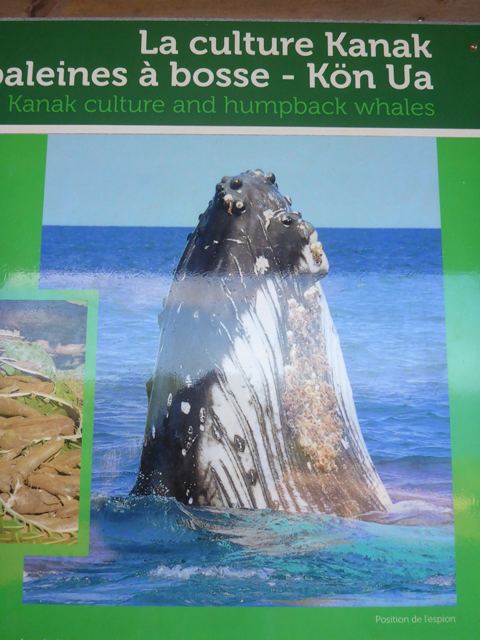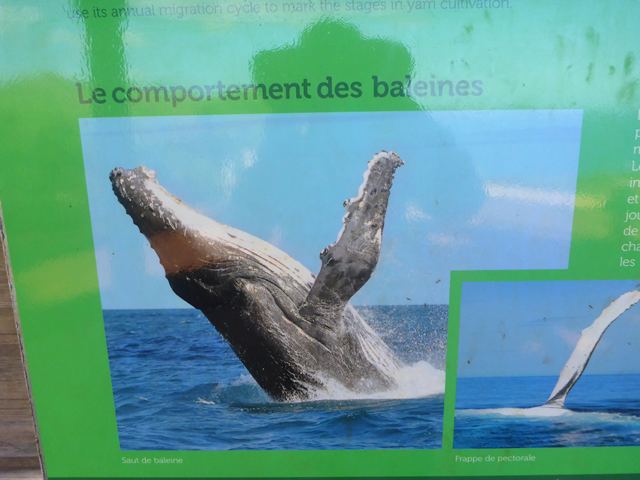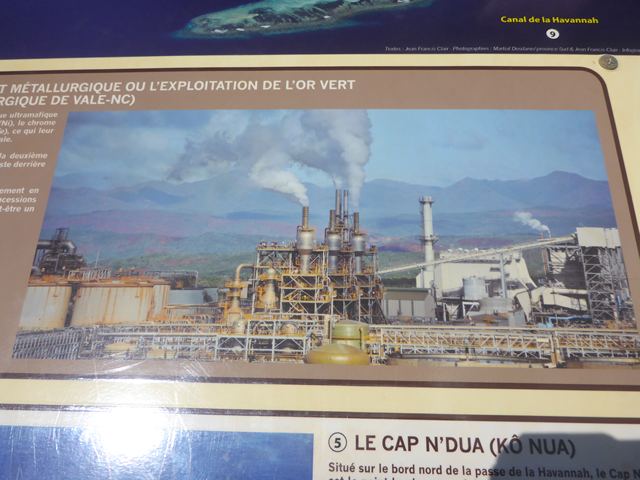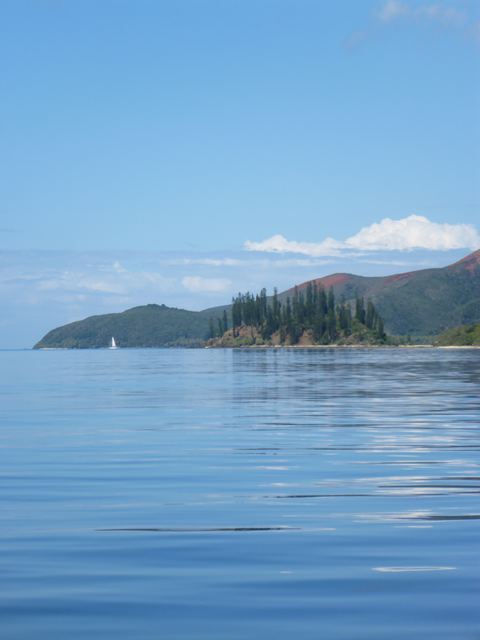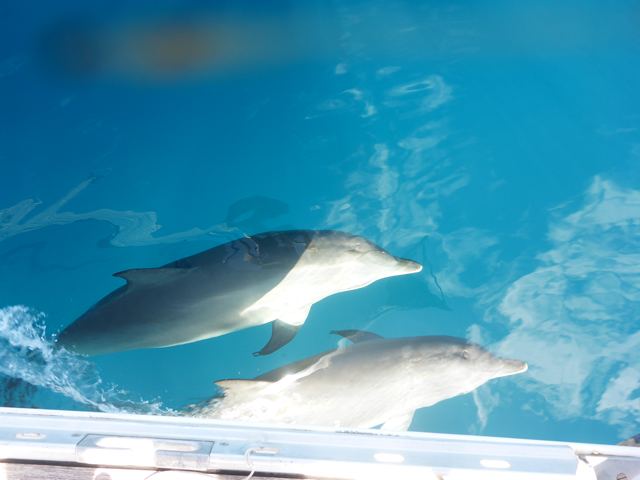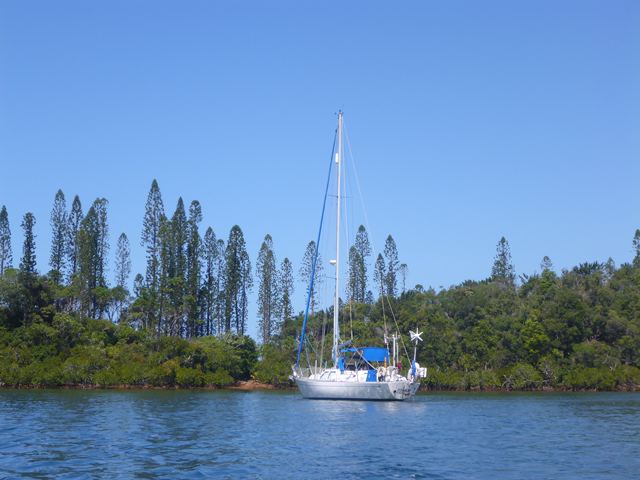Where Have all the Whales Gone

|
Where have all the Whales Gone? We were mystified as to why we had not seen any whales the day before while looking over the Southern Lagoon from Cap N’Dua Lighthouse, after all usually as many as 800 mother humpbacks with their young using the lagoon for its warmth and safety for the baby whales each year. We pondered this mystery as we emerged on another beautiful calm, sunny day from Baie Est, the East Bay of Prony Bay. To our right the audacious concrete covered conveyor belt stretches across the countryside bringing the nickel export product from the processing plant to Prony Port and the waiting ships. The whole site of the Vale NC nickel mine, factory, living area and residue park are being carefully monitored from the aspects of ecological degradation and chemical contamination and the results are mixed and the study ongoing. Ahead of us lay the shores of islets and the mainland opposite with columnar pines and a broad spectrum of colour on the palette of sky, land and sea. Suddenly there is movement in the water ahead, dark fins just cutting the surface, lanquid in their movements until they spot us and then we are joined by a herd of seven spotty tummied Indo-Pacific Bottlenosed Dolphins who play and explore Zoonie’s hull before losing interest and moving away, I don’t think we were going fast enough for them! A little further on a huge yellow and black striped sea snake was sidewinding its way across the water from Ilot Casy to the mainland, a distance of about 4km. “I’m glad he didn’t emerge from around the outboard this morning,” Rob commented remembering the baby sea snake that had been asleep under the fuel tank of the outboard in Fiji last year until Rob started the motor! We tied to a buoy in Baie de la Somme which is so named after the ship of the same name that arrived here on October 9th 1869 to load timber and transport it to the head of the bay. It struck the Recife de l’Aiguille just off the bay and now marked by a red and black pillar buoy, and was stuck there for 50 years until the Guichen helped to refloat it. It is a beautiful wide bay with a handful of buoys at one side under the outcrop of Pine studded land, a resident dark hulled schooner with a couple and a vocal dog aboard in the middle and a river mouth to the other side where the fallout of mud and sand has left a raised bank marked, conveniently, with thin wooden posts or withies. We hadn’t been there long when a big white cat came around the headland and the skipper called across in good English, “These are private buoys for the whale watching boats. You can stay tonight but we will need that buoy tomorrow. You are OK for one night.” “Did you see any whales today?” I asked and he shook his head, a look of regret on his handsome face. He then motored away to pick up another cone shaped buoy before taking his punters ashore. So how does it work when you take a group of keen whale-watchers offshore for the day and there are no whales? In fact there were six whale watching cats that used the buoys and operated from July when the whales arrive to raise their new young and to breed, to mid- September when the mothers and their by now capable and sufficiently mature calves return to the Antarctic to feed on the abundance of cold water Krill. I didn’t know until I read the sign that krill is made up of ten different kinds of crustaceans. You learn something each day in this game. These catamarans are expensive to maintain especially to the standard required to carry paying passengers. The owners have two months only to make their money and this year will have a bad effect on their business. They must be otherwise employed for the rest of the year. Baba and Nora, our Turkish friends from the yacht Tutkum went ashore to Prony Village, the historic penal colony, around the same time as us and spoke to a lady named Captain Woodin at the temporary whale watching base camp that has been monitoring the visiting whales for a number of years. Usually on a single day surveillance covering 90km by boat in the south lagoon they could expect to see 20 to 50 humpbacks. The next day they would see some of the same and other new arrivals as well. This year they have seen as few as one in a day and never more than 5 each day. The season is closing now for this year and who knows how many next year will bring. Can the whale-watching boats be just too much for the mothers’ tolerance? There are strict rules about watching these giant cetaceans, do the boats keep to those rules? The air temperature is 4 – 5 degrees cooler here now than is usual at this time of year, so the water is cooler too, maybe too cool for the babies, so have the mothers taken them further north into the tropics? More alarming is have the mothers failed to breed, are the males still producing live sperm? The drop in numbers is so alarming that I would think the agencies and ecologists will be motivated to find out what has happened and if I discover the answer I will let you know. We relaxed on our buoy for the evening and planned our trip to the old village the next day, wondering who else might turn up in ‘our’ bay.
|
